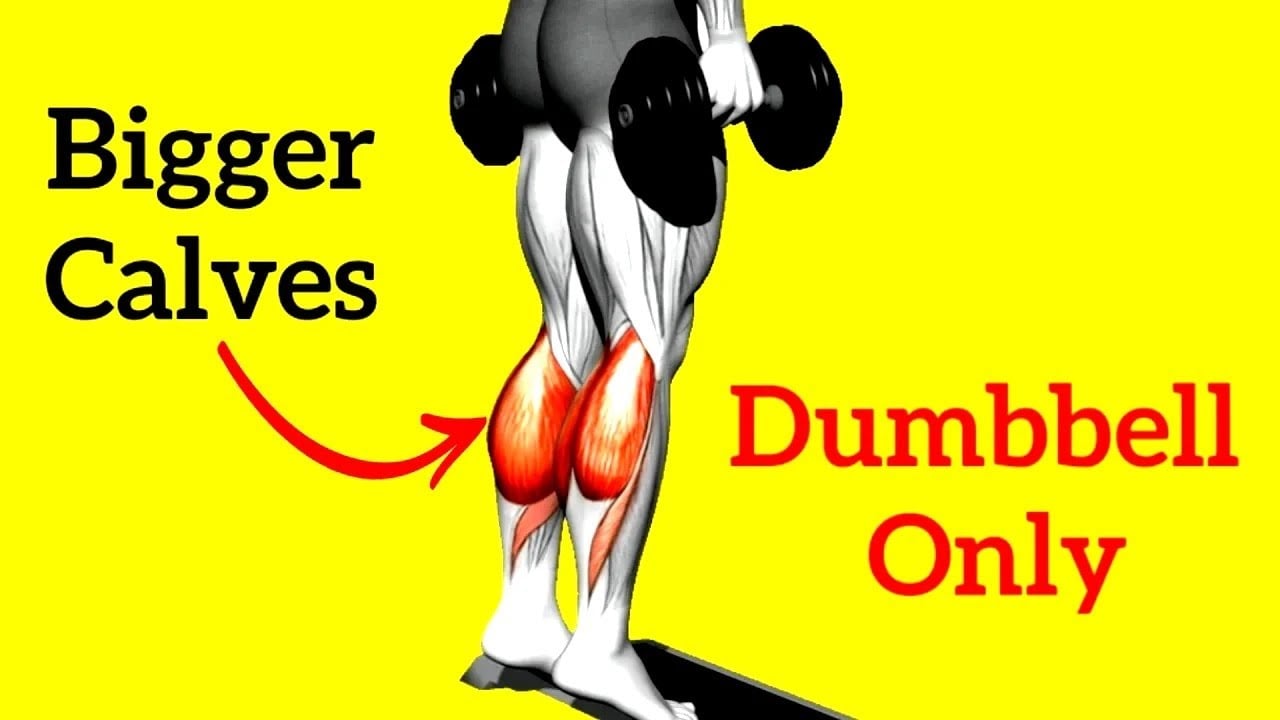Dumbbell calf exercises offer a wide range of variations and intensities, allowing you to effectively target different areas of the calf muscles. Dumbbells are easy to find and can be used at home or in the gym.
As someone who has struggled to build strong and defined calves, I have discovered a secret: adding dumbbell exercises to my calf routine has made a big difference.
You can balance and symmetrically strengthen the calves using dumbbells for calf exercises. It also leads to toned, sculpted calves, which add definition to your lower legs.
In this blog post, we’ll be exploring the following:
- Anatomy of Calf Muscle
- How To Build Calf Muscle With Dumbbell
- Best Dumbbell Calf Exercises
- How to Do It Properly and Correctly
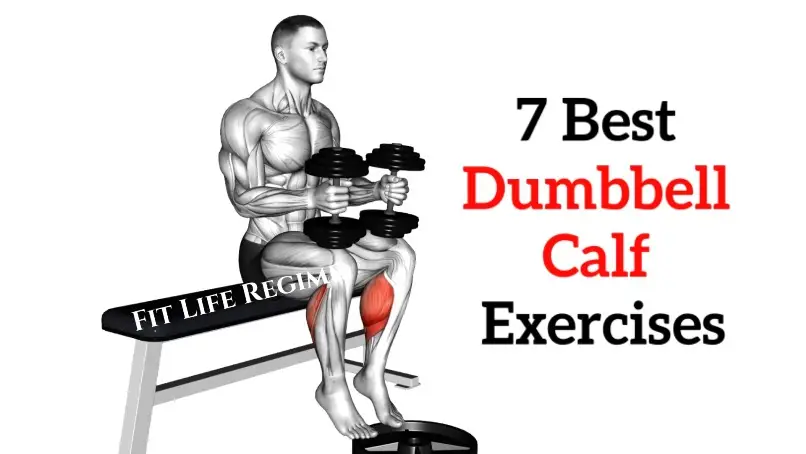
- How To Build a Calf With a Dumbbell
- 7 Best Dumbbell Calf Exercises
- 1. Standing Dumbbell Calf Raise
- 2. Seated Dumbbell Calf Raise
- 3. Dumbbell Farmer’s walk on toes
- 4. Standing One Leg Dumbbell Calf Raise
- 5. Seated Dumbbell One Leg Calf Raise
- 6. Dumbbell Step-Up
- 7. Dumbbell Jump Squat
- Anatomy of Calf Muscle
- Conclusion
How To Build a Calf With a Dumbbell
To build three-dimensional calves, hit them from multiple angles and with varied rep schemes.
- To maximize muscle engagement, focus on each rep lowering (eccentric) and lifting (concentric) portions.
- Varying rep strategies are also critical. Incorporate sets with different rep ranges, like 10–12 reps for hypertrophy (muscle growth) and 20–25 reps for endurance.
- Don’t shy away from challenging weights on some sets. This will stimulate strength gains that translate to sculpted calves.
- Remember, calves are used to high-volume activity, so you can train them more frequently than other muscle groups.
- Pick two or three dumbbell calf exercises to do two or three times a week. Do three sets of each.
- Remember that when performing a standing calf exercise, you focus more on the gastrocnemius, while seated exercises focus more on the soleus muscle.
7 Best Dumbbell Calf Exercises
Here are 7 best dumbbell calf workouts for the best calves around.
1. Standing Dumbbell Calf Raise
If you want to train the calf muscles only with dumbbells, the standing dumbbell calf raise is one of the most suitable exercises. This exercise can be performed anywhere with a dumbbell.
However, during the standing position, when your legs are extended, this exercise will train the gastrocnemius to a higher degree.
A study has shown that calf raises can be done with three different foot positions: outward, inward, and pointed forward.
- Doing calf raises with your feet pointed outward increases the thickness of the medial gastrocnemius muscle,
- While doing calf raises, your feet are pointed inward, which increases the thickness of the lateral gastrocnemius muscle.
- For a more balanced approach, keep your toes pointing straight ahead.
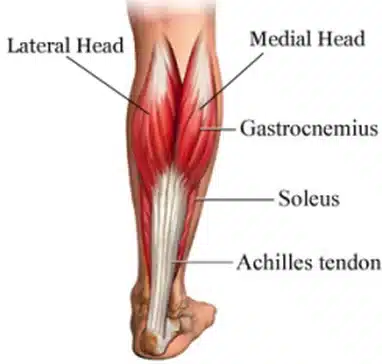
How To Do
- Find an elevated surface that allows your heels to drop. The stairs and stepper work great.
- Hold a dumbbell in each hand by your sides.
- Stand up straight on the stepper with your feet facing forward and placed hip-width apart.
- Keep a slight bend in your knee and hold your hands by your side.
- Raise your heels by pressing the balls of your feet into the ground.
- You should move your body upwards until you’re standing on your toes.
- Hold this position, and then slowly lower your heels back to the ground.
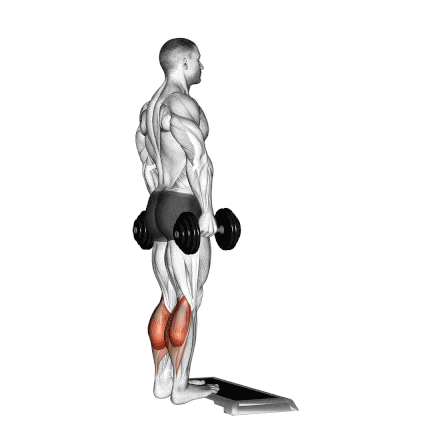
Tips
- Pause and squeeze for a count of 1-2 at the movement’s top for added intensity.
- Keep the balls of your feet on the edge of the block/step. If you allow the balls of your feet to come in more, the exercise becomes easier.
2. Seated Dumbbell Calf Raise
Compared to standing calf raises, seated calf raises isolate your calf muscles, specifically the Soleus muscle, by minimizing the involvement of your core and stabilizer muscles like the quadriceps and glutes. This allows for a more targeted workout on your calves.
When performing the seated version of the calf raises, it’s important to get a good stretch on the bottom and squeeze at the top.
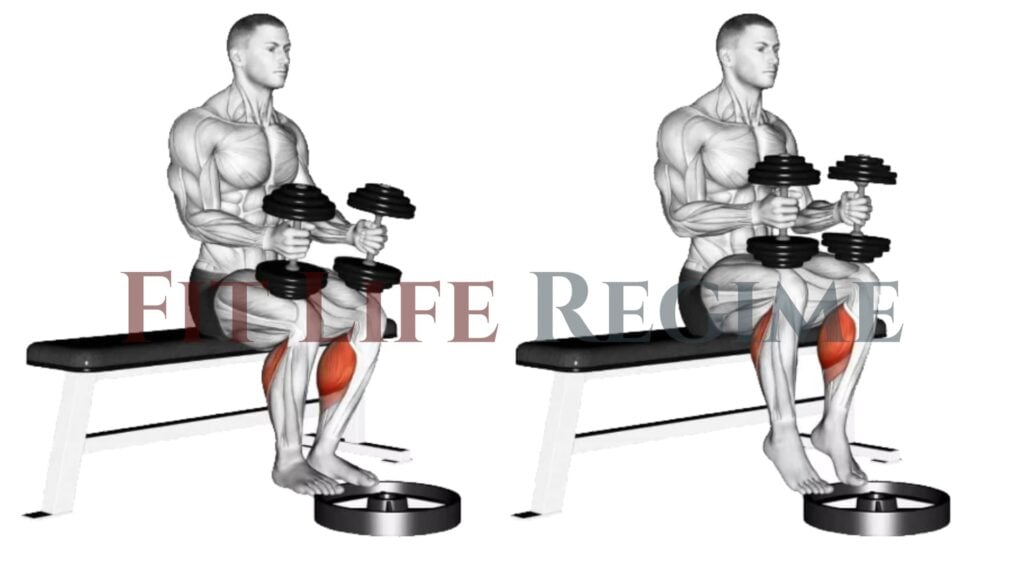
How To Do
- Find a sturdy bench or chair that allows your knees to bend comfortably at a 90-degree angle when you sit.
- Rest the balls of your feet on a block or plates. Hold a dumbbell in each hand and rest them on your thighs.
- Allow your heels to drift toward the floor until you feel a stretch in your calves.
- Now, drive the balls of your feet into the platform and raise your heels as high as possible.
Tips
- Move slowly as you stretch your calf muscle.
- Make sure you hold the stretch for a second at the top, returning to the starting position.
- Engage your core to keep your torso upright throughout the exercise.
- Experiment with different foot positions, such as toes pointed forward or slightly turned out, to target different areas of the calf muscles
3. Dumbbell Farmer’s walk on toes
The Dumbbell Farmer’s Walk is a simple but effective way to train the entire body in one go.
However, you can perform the farmer walks on the toes. That way, you will amplify the calf muscle. This keeps calves constantly tense, stretched, and loaded.
Try the exercise with light weights first, and then add or increase the weights as you feel comfortable and more stable.
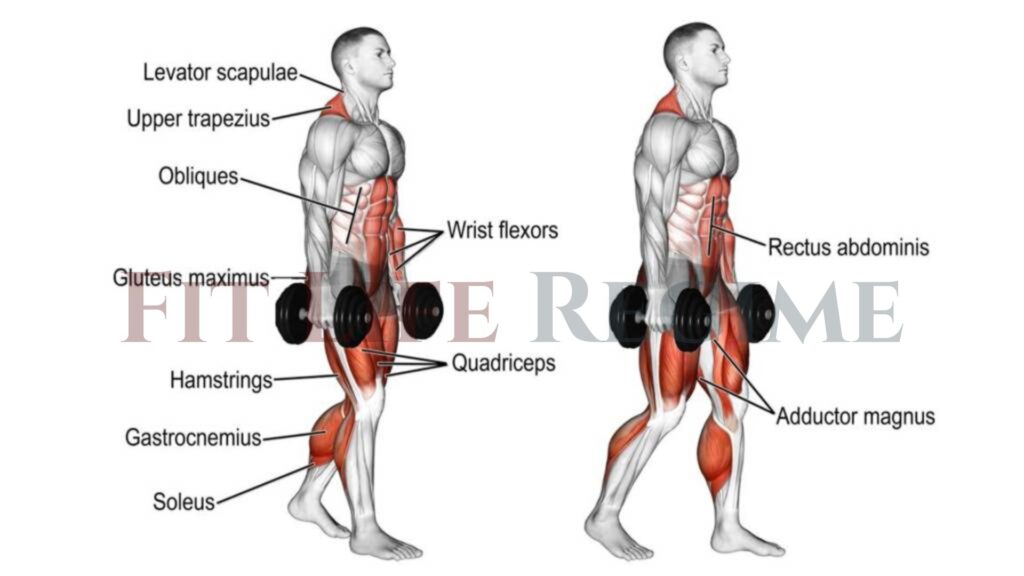
How To Do
- Grab a set of dumbbells and hold them at your sides with your arms extended.
- Stand together with a long, tall spine and feet, and brace your core strongly.
- Raise up onto your toes. Take a small step forward, staying as high on your toes as possible.
- Continue moving forward, taking 20-30 small steps.
Tips
- As you walk, squeeze your calf muscles and stay high on your toes.
- Keep your shoulders pulled back, chest up, and core engaged for stability.
4. Standing One Leg Dumbbell Calf Raise
The standing dumbbell one-leg calf raise is a very effective isolation calf exercise that targets the Gastrocnemius and Soleus muscles.
If you don’t have a platform to perform the standing dumbbell one-leg calf raises from, you can do it on the floor.

How To Do
- Hold a dumbbell by your side in your left hand.
- With your left foot, stand on a platform, with the arch and heel of your foot suspending off.
- Grasp something with your right hand for stability.
- Exhale as you raise your heel by extending your ankle.
- Hold for a count. Inhale as you slowly reverse the motion and lower your heel until you feel a mild stretch in your calf.
- Hold for a count of one. Repeat for more repetitions. Repeat with your right leg.
Tips
- Keep the movement slow and under control.
- Do not lock out your knee.
5. Seated Dumbbell One Leg Calf Raise
The one-leg seated dumbbell calf raise exercise places more stress on the soleus than it does on the gastrocnemius.
It may also be performed with both legs simultaneously, but it is recommended that you do it one leg at a time to execute it as properly and safely as possible. It is one of my favorite calf exercises. It helps create a good mind-muscle connection.
It can be used as an alternative if you cannot access the seated calf-raise machine.

How To Do
- Sit with the front of your right foot placed on top of a block or step in front of you.
- Hips and knees should be bent at a ninety-degree angle.
- Dip the heel of your right foot as low as it can go.
- Hold a dumbbell vertically on top of your right knee.
- Exhale as you lift your right heel as high as possible, pushing against the dumbbell’s weight.
- Keep your right heel lifted for 2 counts. Slowly lower it as you inhale.
- Repeat the exercise on your left foot.
Tips
- Move slowly as you stretch your calf muscle.
- Make sure you hold the stretch for a second at the top, returning to the starting position.
- Engage your core to keep your torso upright throughout the exercise.
6. Dumbbell Step-Up
Unlike isolated calf raises, dumbbell step-ups are a compound exercise that simultaneously works multiple muscle groups, including your calves, hamstrings, quadriceps, glutes, and hip flexors.
After doing it, I felt a complete burn in my leg, and it helped me build lower-body strength and power.
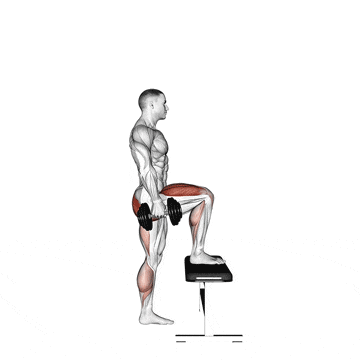
How To Do
- Place a knee-high box or bench in front of you and grasp a dumbbell in each hand, or use your body weight.
- Stand with your feet in a comfortable hip-width stance.
- Step forward with one leg onto the step and drive through that thigh to bring your body upward.
- Bring the trailing leg to the top of the step and stand on the box.
- Then step back with the opposite leg to the floor and lower yourself—alternate legs with each rep.
Tips
- Control the movement, using your muscles to lift and lower yourself slowly.
- Be sure to keep your lower back in its natural arch and your upper body upright throughout the movement.
- Keep your body upright and your feet and knees pointing in the same direction.
7. Dumbbell Jump Squat
Calf raises are great, but if you’re looking for an explosive way to torch your calves and take your leg workouts to the next level, then take the weights and jump.
Dumbbell Jump Squats are a plyometric exercise that involves a quick muscle contraction followed by an explosive extension. They are the power-packed HIIT version of squats, which combines strength and cardio.
First, start with body weight and move to weights.

How To Do
- Stand with your feet about shoulder-width apart and your knees slightly bent.
- Quickly drop by bending at the knees and hips, letting your glutes track backward to lower yourself into a squat.
- At the point where your thighs are parallel to the floor, quickly and explosively reverse direction, driving up through your heels and the balls of your feet to lift your body off the floor as high as possible.
- Land with soft knees and immediately lower into the next rep.

Tips
- Don’t jump straight into heavy weights. Begin with lighter dumbbells (or even no weight).
- Don’t perform this exercise with cold muscles. Do a cardio warm-up before it.
- Try to land and bend your knees to absorb the impact gently. Avoid landing with rigid legs, which can stress your knees and ankles.
Anatomy of Calf Muscle
The calves are a powerful set of three muscles situated on the lower leg’s posterior.
The calf muscle consists of two main superficial muscles: the upper gastrocnemius, and the lower soleus.
These are located at the back of your lower leg. They join together to become your Achilles tendon, which attaches to your heel.
- The gastrocnemius is the visible muscle of the calf. Its two heads (medial and lateral) arise from the rear of the femur bone, immediately above the knee joint.
- The soleus arises from the rear aspect of the tibia and lies underneath the gastrocnemius.
In addition to these two large muscles, a small muscle called the plantaris runs between the gastrocnemius and soleus down the length of the lower leg.
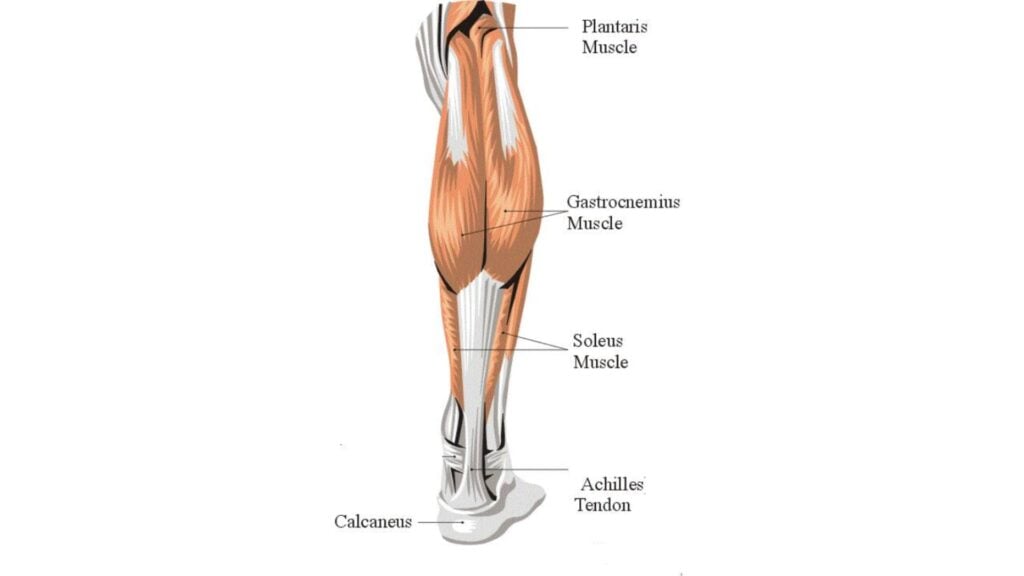
Conclusion
Adding dumbbell exercises to your workout routine can help you build stronger calves. The seven exercises we have discussed are highly effective in targeting the calf muscles.
It is recommended that you perform two to three calf exercises per workout. This lets you target the calf muscles from different angles and give them enough stimulation to grow and build strength.
So grab your dumbbells and get ready to sculpt those calves.

Manish is a NASM-certified fitness and nutrition coach with over 10 years of experience in weight lifting and fat loss fitness coaching. He specializes in gym-based training and has a lot of knowledge about exercise, lifting technique, biomechanics, and more.
Through “Fit Life Regime,” he generously shares the insights he’s gained over a decade in the field. His goal is to equip others with the knowledge to start their own fitness journey.

